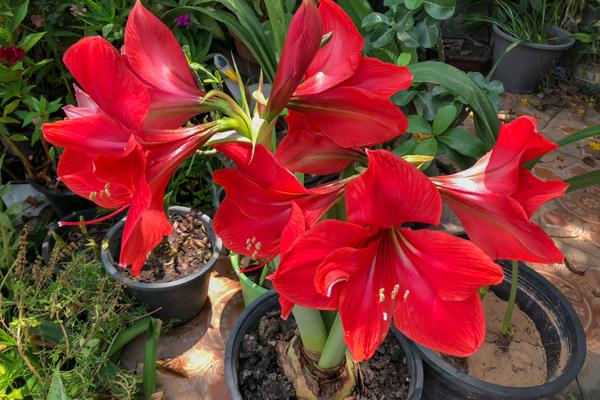Nothing brightens up a cold winter day like a blooming amaryllis bulb (Hippeastrum sp.)! Above the strappy foliage, the flower stalk can stretch over two feet high, topped with a stunning display of huge, trumpet-shaped flowers in shades of pink, red, white, and even orange – with some gorgeous striped varieties available as well.
If you live in planting zones 9 and warmer, you can grow amaryllis outdoors in full sun flower beds, where they will bloom naturally in the spring and summer. For the rest of us, amaryllis are grown in pots and forced to bloom, usually during the gray winter when we most need it most. But fear not! Amaryllis are quite easy to grow indoors, here’s how.
Choosing Amaryllis
You can buy amaryllis as a potted plant, as a bulb kit with pot and soil, or as individual bare bulbs. If you’re new to amaryllis or are buying it as a gift, look for pre-potted bulbs that already have a flower bud sprouting. The flower bud is easy to identify – it’s thick and pointed – whereas the leaves are thin and strappy. The bud sprouts first, so if the plant only has leaves, it isn’t going to bloom this year.
Amaryllis Growing Tips
- Choosing the right Container: Amaryllis bulbs only need about an inch of space around the bulb. One bulb can usually be planted in a 6” diameter pot, or three bulbs together in a 10”- 12” pot. Be sure the pot has drainage holes in the bottom.
- Planting the Bulb: Plant your amaryllis in light, well-draining potting mix, with the top 1/3 of the bulb sticking up out of the soil.
- Watering needs: Water the amaryllis whenever the top inch of soil feels dry. Avoid letting the bulb sit in wet soil, and avoid pouring water down into the crown of the bulb. As your bulb grows larger and has more roots, it may dry out more frequently.
- Fertilize properly: While the amaryllis is growing, feed it every couple of weeks with a balanced organic fertilizer, or add a slow-release fertilizer when planting.
- Just the right amount of Light: Place the amaryllis in a bright window. Turn the pot regularly, since the flower stalk will lean toward the light.
- Bloom Care: Once your plant blooms, the flowers will last longer if you remove it from direct sunlight and put it in a slightly cooler spot (a good reason to put it on a table where you can enjoy it!). Gently stake the flower stalk if it’s top-heavy, but be careful not to pierce the bulb with the stake.
Year-Round Amaryllis Care
Some people throw away their amaryllis after it blooms, but you can keep it year-round. With a little care, your amaryllis can be encouraged to bloom again and again. Follow these tips to continue caring for your amaryllis:
- Remove Spent Flowers: After the amaryllis blooms fade, cut them off individually. Then, when the entire flower stalk starts to wilt, cut off the stalk just above where it sprouts from the bulb.
- Encourage Foliage: Put your amaryllis outdoors for the summer, so that the foliage can grow and feed the bulb for next year’s blooms. Simply bury the pot up to its rim in mulch, and it’ll dress up your flower beds. Keep it regularly watered, and continue feeding every couple of weeks.
- Cold Storage: In the early fall, the leaves will naturally turn yellow and die. At that point, gently dig up your amaryllis bulb, cut off the dead leaves, wipe the bulb clean, and store it for 6 weeks in a cold, dark spot (40°-50° F). In cool climates, an unheated shed or garage is perfect. Those in warmer climates can put the bulb in the fridge. Don’t expose the amaryllis bulb to freezing temperatures.
- Container Storage: As an alternative, you can cut off the dead leaves and leave the amaryllis bulb in its pot for cold storage, then simply bring the pot back out and resume watering after 6 weeks. I haven’t had good luck with reblooming with this method, but it’s worth a try if you want a low-maintenance option. Plant with 1/3 of bulb above soil.
- Replanting Bulb: After at least 6 weeks of cold storage, amaryllis bulbs are ready to plant again. They will take 8-10 weeks to sprout and bloom, so you can time the planting to coincide with the holidays or a special event. If you have multiple bulbs, you can plant one every two weeks, all the way until February, for a parade of blossoms until summer.
- Propagating: As your amaryllis bulb gets older, it may produce little babies, called bulblets, attached to the mother bulb. To propagate the bulblets, use a sharp knife to cut them off the mother bulb right before repotting, then plant them individually. The baby bulbs will take several years to flower, but they need to be kept on the same care schedule as the mother.
- Bloom Failure: It can be tricky to get an amaryllis to rebloom. If yours doesn’t bloom this year, simply repeat the schedule this year, making sure to give it regular balanced fertilizer.
For more information on growing Amaryllis, you can refer to:
- Growing the Delightful Amaryllis (North Dakota State University)
- Growing Guide: Amaryllis (White Flower Farm)
—
Photo Credit: fon.tepsoda / Shutterstock.com
